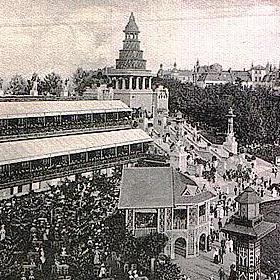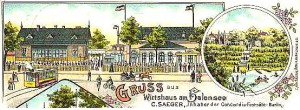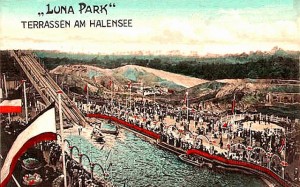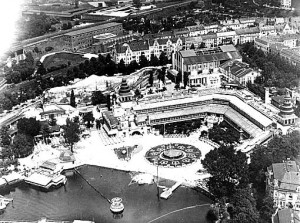

Luna Park
”Spring in Berlin received its official sanction as a season of merriment, with the opening of the enormous Luna Park, just beyond the Halensee Bridge, set by the Gods of sensations at the very end of the Kurfürstendamm, which seems like one never-sending promise of sensations. Here the fun becomes insane, the absurdity hyperbolic, the jollification both strenuous and harmless. There are infernal machines that cause bitter sweat before they rouse any joys: a deranged pyramid that tries to top its own summit. Undemanding fun becomes its own caricature. How strange that someone trying to have a good time will walk up an uncertain jazz band staircase, get stuck halfway up, unable to go up or down, and instead of laughing, finds himself laughed at by everyone else.”
Joseph Roth – Frankfurter Zeitung, May 16th, 1924
Between 1909 and 1933, Europes largest amusement park was Luna Park, in the Halensee area of Berlin at the far end of the Kurfüstendamm.

At the turn of the century, Wirtshaus am Halensee was a substantial guest house on the east shore of the lake, a popular outdoor swimming area. Daytrippers would travel by carriage down the forest path that is now the Kurfürstendamm toward the Grunewald and stop for refreshments and amusement. In the grounds of the hotel were fairground rides, stalls and even a water slide.
Sensing a larger opportunity, in 1909 the hotel was acquired by restauranteur August Aschinger and chef Bernd Hoffman, who set about transforming the grounds into a spectacular amusement park.

Very much modelled on New York’s Coney Island, the park featured all the typical attractions of the time. The water slide was enlarged and now ended in the lake itself, a shaking staircase (shimmy-treppe) that had a fan to lift ladies skirts and an elevated ‘mountain’ railway. There was also a swimming pool featuring the world’s first-ever artificial wave machine.

There were also theatres, jazz and cabaret stages, dance halls and boxing tournaments. The restaurants and bars could seat 16,000 people, there was a Bavarian-themed ‘beer village’ and nightly fireworks displays.
Within it’s first few years, Luna Park was attracting 50,000 visitors a day and already, by the end of the 1910 season, had welcomed it’s millionth visitor. The enormous success of Luna Park led to the rapid development of the Kurfüstendamm
”Someone tries to cover a target with six flat rubber disks. He throws one after another, hoping to win himself a wristwatch. The desire to win impels his arm, the fear of losing holds it back, and his excited consciousness, the seat of prudence and of frivolity, wavers between the will to throw and the trembling arm. Meanwhile, any jewellery store would offer him the same ‘guaranteed 100 percent Swiss watch’ for the same money and with no exertion or risk.”
Joseph Roth, 1924
The park closed for the duration of the First World War but reopened in 1918. However, it’s glory days were behind it and, in the years that followed, it fell into disrepair. The hyper-inflation of the early 1920′s was disastrous and visitor numbers rapidly declined.
A major refurbishment took place over the Winter of 1928 and the park was relaunched to the public in May 1929, however, it never quite achieved it’s former success.

On taking power in 1933, the Nazis immediately closed the park and, considering it an eyesore, completely demolished the site in 1935 to make way for the Halenseestraße, in time for the 1936 Olympics
